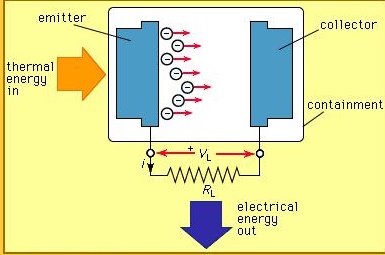Chapter: Mechanical and Electrical : Power Plant Engineering : Power From Renewable Energy
Thermo ionic conversion system
Thermo ionic conversion system
Introduction:
A thermionic converter can be
analyzed from at least three different points of view:
1.
In
terms of thermodynamics, it may be viewed as a heat-engine that uses an
electron gas as a working substance.
2.
In
terms of electronics, it may be viewed as a diode that transforms heat to
electricity by the law of thermionic emission.
3.
In
terms of thermoelectricity, it may be viewed as a thermocouple in which an
evacuated space or a plasma has been substituted for one of the conductors.
Regardless
of the point of view adopted in analysis, a thermionic converter works because
of the phenomenon ofthermionic‘ emission Thermionic‘. emission implies emission
of electrons from the metal when it is heated.
Work
function (f):
It
is defined as the energy required to extract an electron from the metal. It is
measure in electron volts. The value of work function varies with the nature of
the metal and its surface condition.
A
thermionic converter, in principle, consists of two metals or electrodes with
different work functions sealed into an evacuated vessel. The electrode with a
large work function is maintained at a higher temperature that one with the
smaller work function.
Thermionic generators:

Figure: Thermionic generator
A thermionic converter/generator comprises a heated
cathode (electron emitter) and an anode (electron collector) separated by a
vacuum, the electrical output circuit being connected between the two as shown
in figure. The heat which is supplied to the cathode raises the energy of its
electrons to such a level that it enables them to escape from the surface and
flow to the anode. At the anode the energy of electrons appears partially as
heat, removed by cooling and partially as electrical energy delivered to the
circuit. Although the distance between anode and cathode is only about one
millimeter, the negative space charge with such an arrangement hinders the
passage of the electrons and must be reduced, this can be achieved by
introducing positive ions into the interelectrode space, cesium vapour being
valuable source of such ions.
In order to materialize a substantial electron emission
rate (per unit area of emitter), and hence a significant current output as well
as a high efficiency, the emitter temperature in a thermionic converter containing
cesium should be atleast 1000°C, the efficiency is then 10 per
cent.
Efficiency as high as 40 percent can be obtained by
operating at still higher temperatures. Although temperature has little effect
on the voltage generated, the increase in current (per unit emitter area)
associated with a temperature increase results in increase in power. Electric
power
(P) is
the product of voltage (E) and current (I) i.e., P = EI.
Anode materials should have a low work function e.g.,
barium and strontium oxides while that of the cathode should be considerable
higher, tungsten impregnated with a barium compound being a suitable material.
Even with these materials temperatures upto 2000°C will be required to secure for the
generator itself, efficiencies of 30-35 percent. Electrical outputs of about 6
W/cm2 of anode surface are envisaged with about 13 W/cm2
removed by coolant.
A thermionic generator, in principle can make use of any
fuel (may be fossil fuel, a nuclear fuel or solar energy) subject to the
condition that sufficiently high temperatures are obtainable. The thermionic
conversion can be utilized in several different situations –remote locations on
the earth and in space.
Thermionic
converter materials. The
problem of developing materials suitable for use in thermionic
converters ranks next to the space charge control problem in the development of
efficient thermionic generators. Following properties are desirable in
materials suitable for converters:
Emitter.
A good emitter will:
(i)
have
high-electron emission capability coupled with a low rate of deterioration.
(ii)have low emissivity, to reduce heat transfer by radiation
from the emitter.
(iii) be such that in the event some of it
vaporizes and the subsequently condenses on the
collective).
The
relative importance of these properties is dependent upon the type of converter
being designed. It should be noted that efficiency is a much slower rising
function of electron emission capability if space charge is present than if
there is no space charge.
The work function may be reduced considerable by an
absorbed single layer of foreign atoms. This comes about by the establishment
of a dipole layer at the surface. The layer can be formed by atoms or
molecules. This is essentially what happens in a cesium converter, which is
designed so that cesium condenses on the emitter or collector.
Collector:
The main criteria for choosing a collector material is
that it should have as low a work function as possible. Because the collector
temperature is held below any temperature that will cause significant electron
emission, its actual emission characteristics are of no consequence. The lower
of the collector work function(fc), however the less energy the
electron will have to give up as it enters the collector surface. In practice
the lowest value of fC than can be maintained stably is about 1.5 eV. For
applications in which it is desirable to maintain the collector elevated
temperatures (greater than 900°K) such as space applications, an
optimum value of fc may be determined. Molybdenum has been widely used as a
collector; it is frequently assumed to have a work function of 1.7 eV.
Related Topics